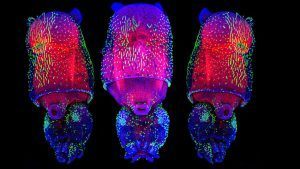Elizabeth Pennisi in Science:
 Billions of years ago, life crossed a threshold. Single cells started to band together, and a world of formless, unicellular life was on course to evolve into the riot of shapes and functions of multicellular life today, from ants to pear trees to people. It’s a transition as momentous as any in the history of life, and until recently we had no idea how it happened.
Billions of years ago, life crossed a threshold. Single cells started to band together, and a world of formless, unicellular life was on course to evolve into the riot of shapes and functions of multicellular life today, from ants to pear trees to people. It’s a transition as momentous as any in the history of life, and until recently we had no idea how it happened.
The gulf between unicellular and multicellular life seems almost unbridgeable. A single cell’s existence is simple and limited. Like hermits, microbes need only be concerned with feeding themselves; neither coordination nor cooperation with others is necessary, though some microbes occasionally join forces. In contrast, cells in a multicellular organism, from the four cells in some algae to the 37 trillion in a human, give up their independence to stick together tenaciously; they take on specialized functions, and they curtail their own reproduction for the greater good, growing only as much as they need to fulfill their functions. When they rebel, cancer can break out.
Multicellularity brings new capabilities. Animals, for example, gain mobility for seeking better habitat, eluding predators, and chasing down prey. Plants can probe deep into the soil for water and nutrients; they can also grow toward sunny spots to maximize photosynthesis. Fungi build massive reproductive structures to spread their spores. But for all of multicellularity’s benefits, says László Nagy, an evolutionary biologist at the Biological Research Centre of the Hungarian Academy of Sciences in Szeged, it has traditionally “been viewed as a major transition with large genetic hurdles to it.”
More here.
